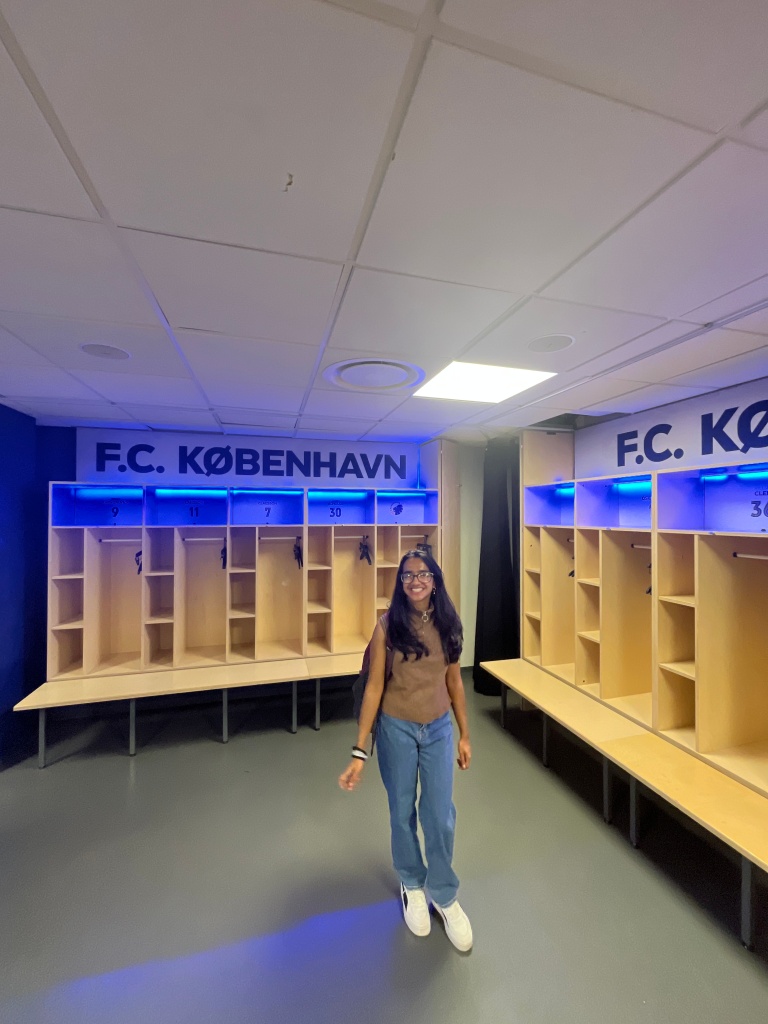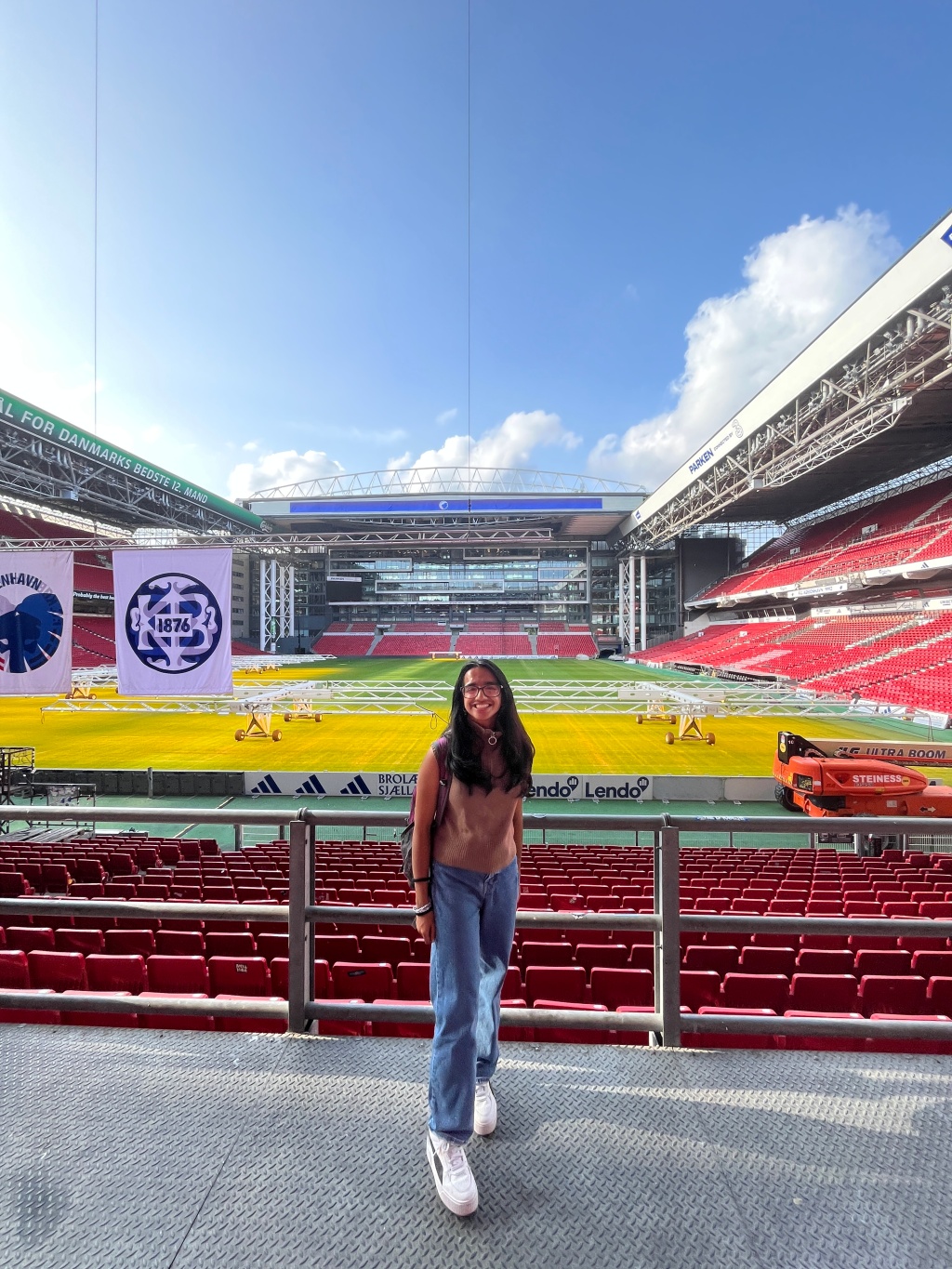One of the things that stood out to me while choosing my study abroad program was DIS’ emphasis on experiential learning. I knew that I thrived in an environment where I got see what I was learning outside of the traditional classroom/lecture setting.
Scandinavia as your home, Europe as your classroom
This slogan is a trademark of DIS that truly highlights the place-based learning methods employed by the program throughout the academic experience. DIS highlights that while you can simulate an experience from anywhere, place-based learning depends directly on the physical spaces around you. They engage with the idea of having this ‘global mindset’ and having the city of Copenhagen as your “classroom” through field studies (I will go through all mine down below). I knew I would be getting these experiences during the big travel weeks with my core course (check out my Short Study Tour and Long Study Tour blogs) but I loved how our Wednesday’s were blocked for two field studies per course throughout the semester to gain various experiences in the city. The consistency of engaging in weekly outskirts and seeing more of Copenhagen was a HUGE reason why I loved my experience so much at DIS and ultimately fell in love with the city.
Travel Writing 🚪
Creative writing has been one of my weakness’ so I took this course to challenge myself and to relearn what it’s like to be creative (plus being a student blogger helps me). Storytelling is a artform which I strive to be good at but this course taught me to hone in on many skills in order for that to occur. A core memory for this course was when the professor took us out to Israel Plads and we had to interview strangers without any structure and without telling them it’s for class. The goal was to let them just talk and I learned…
..”To look at the interview is to understand writing not as the solitary endeavor of the genius performing her sorcery but as relationship, as negotiation, in which a writer is trying to simultaneously remove herself entirely from a story — to in fact scribble out her assumptions and readings — and to purposefully tell that story with all her skill, will, and vision.“- Sarah Menkedick
Fun Fact: With this challenge, I made two new friends that attend Copenhagen Business School and I stayed in contact throughout my semester… so I made local friends through class
Travel writing built many fields studies that involved street exercises like taking our notebooks and writing detailed notes about senses we observe at Trinitatis Church, Arnold Busck book store, and more. I learned… “You may be surprised at just how one sense can add interesting layers of description”–prof Christian
BUT HERE ARE THE OFFICIAL FIELD STUDIES FOR TRAVEL WRITING:
- Tivoli: Hidden Stories 🔑
We got free entrance to Tivoli and walked around for 2 hours discussing some of the history behind the artitecture. The biggest lesson was that despite how in travel writing most people want to hear the “good” and “beautiful aspects” of destinations, there’s always a hidden story behind that which isn’t talked about. A lot of the dark sides of history are often not published because it’s not what people want to hear and bad stories don’t make profit. That’s how a lot of things get buried (literally…because it’s people who hold these stories and once they die it’s gone forever) so it’s important to slow down and talk to people… often you would find a story that’s hidden (of course doesn’t always have to be “dark”). Afterwards my classmates and I bonded and rode some roller coasters!!






2. Visit to The Adventurers’ Club of Denmark 🇩🇰
Our class got a tour of their headquarter near Nyhavn and learned about the razy pioneers who founded it 80 years ago (no pictures because they want to keep it a secret!). Tore Grønne, an experienced adventurer and travel writer gave us a tour and told us about his journeys biking through South America, Central Asia, the Himalayas, and more!
This was hands down the best field study in terms of all of my field studies this whole semester because I walked away from this feeling inspired, changed, and introspective about my future of adventures.
Tore said “Leading an adventurous life can be accessible to everyone. Adventures is not measured by time, it can be short or long, but if you travel make sure you do it slowly. Sit down and talk to people. You are never going to know where that one interaction is going to lead you.”
Creative Industries: Business, Culture, and Politics 🚗
Based on the similar theme of creativity.. I got to see how it’s applied in society through many industries such as artitecture, sports, music, photography, and arts & culture. This class was built on experiences outside of the classroom and really seeing creative industries in Denmark. Creative industries are activities which have their origin in individual creativity, skill and talent, and have a potential for wealth and job creation through the generation and exploitation of intellectual property. Overall, this class taught me that creativity is needed in order for industries to thrive: once I feel more creative that will be a huge asset to the world.
1. Danish Royal Theater– Culture and Arts 🎭
I learned that culture defined in Denmark is “way of life whose basis is the general freedom of action vested in the people”. We got a tour of the Royal Theater and my favorite part was seeing the dancers practice, walking on the stage and seeing the crew clean, and seeing the costumes being sketched and hand designed. Such a surreal experience.




2. Danish Architecture Center + City Walk 🏰
The Danish architecture industry focuses on design innovation, urban development, and sustainability regarding people, places, and spaces. We went on a city tour saw Slotsholmen (Castle), Christiansborg Slotsplad, Island Brygge, Papirøen, and so much more. Lastly, we went to the DAC and saw a really cool slide and learned about the iconic architecture in the city formally.






3. Parken – Sports Industry ⚽️
Got a tour of the FC København (professional Danish football club in
Copenhagen, Denmark) stadium. It’s crazy how they change the entire flooring and stadium for the national team. They have pipes that run 100 meters that just supply beer for the games. They use this stadium for concerts people like Justin Bieber, Madonna, ColdPlay, and more have been in the rooms we were in! Also, seeing Section 12 sits behind the home goal and is the heart of the atmosphere in Parken (I’ve never seen so much pride ever!) … Such a cool experience.







4. Photography 📷 📸
We went to a private photography studio in Amma and got lessons on how to take pictures. It was interesting learning how clients as for pictures of themselves, but want it heavily edited to the point that it doesn’t look like them. Our instructors talks about the ethics of editing photography and why she’s worried that AI and digitalization is destroying the originality of the industry.




5. VEGA Concert– Music Industry 💽
We got a tour of the VEGA concert venue located in Vesterbro. This venue was interesting because it can hold around 5-6 different concerts at the same time. The building was designed by Vilhelm Lauritzen who also designed Copenhagen Airport and we could see a lot of elements of efficiency there. We saw KUNDO afterwards as a class which was a great bonding experience.






6. Restaurant Barr – Culinary Industry 🍝
Barr was founded by chef and restaurateur Thorsten Schmidt, a longtime friend of Redzepi (who was apart of the New Nordic Movement). This was such a surreal experience to hear how the life of being a chef in fine dining works. I loved learning about the Michelin system and didn’t know it was started from the tire company!

Healthcare Strategies At Risk Populations 🚨
As a public health major, this class was very insightful in comparing Danish healthcare and American healthcare for sex workers, migrants, homeless, lgbtq+, and other populations who are often neglected in the healthcare setting. I left this class with more questions than answers about how I view healthcare strategies since not all that I learned here can be applied in America … (which is good for me to reflect on and makes me want to pursue more global health studies)
1.H17 Visit– Safe Injection Site 💉
I found the visit to H17 to be one of the most informative and authentic field study at DIS this semester. I think this helped me to break down preconceptions about how users live– they need the same basic things as any other human. I was definitely aware that my initial reactions to some of the facilities might have stemmed from some biases I have regarding drug use. I think that kind of experience where I questioned myself is truly a privilege because not a lot of people get to experience that. This is an important part of the harm reduction approach, and means providing resources such as human interaction, food, clothes, and a place to stay. I really applaud and appreciate the work that they are doing.
“these people are one step above the lowest point which is death and imprisonment”- our speaker
Another point that was interesting to me was the setup and architecture of the place. I have never thought about the fact that metal chairs could disturb them or the fact that color theory really can calm the mind. He said that they wanted the fish tank and the plants because nature is what brings people together and I think that was really interesting to think about because that’s the farthest thing I would worry about in a SIF.



2. Red Cross 🩺
I learned how hard it is to access healthcare as a migrant in Denmark especially if you don’t have a CPR card. The Red Cross provides great services but are severely understaffed and don’t have the best cultural competency training.

Health Economics and Health Policy 🦠
A great class to learn more about health economics… the main lesson I learned was the welfare system makes the economics more complex (definitely one of the most hardest classes for me since I don’t know much economics which is fine because they taught me so much)
1. Danish Research Centre for Magnetic Resonance 🦼
The Danish Research Centre for Magnetic Resonance at the University Hospital of Hvidovre is one of the leading research centres in Europe within the field of biomedical MRI. Here, a highly profiled international research team translates the latest advances in MRI to examine the brain’s function, metabolism and structure. We learned about the research centre, got a grasp of Danish life science research, and focused on one particular research project funded by the Lundbeck Foundation. (ADAptive and Precise brain-circuit Targeting in Parkinson’s disease – “ADAPT-PD”). One of the work packages in this project will test the effect of using intracranial brain stimulation to prevent dyskinesia in PD patients


Overall I enjoyed all my field studies and think that they shaped my experience at DIS… it’s one of the best parts.
As I reminisce and reflect upon my time abroad stay tuned for more blogs 🙂

Leave a comment